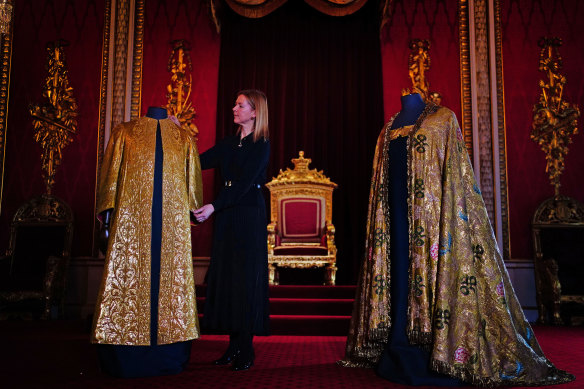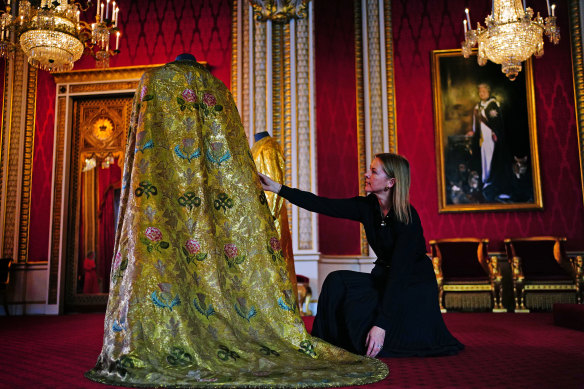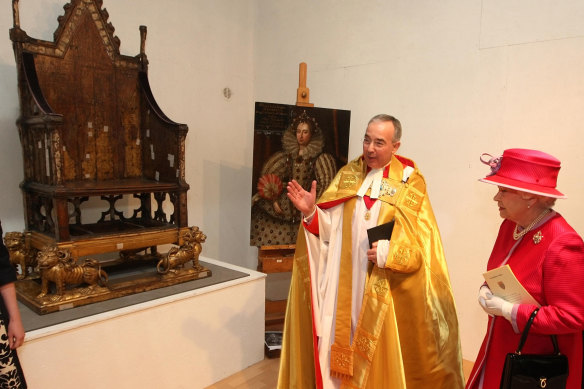This was published 1 year ago
Charles to recycle robes and thrones for more sustainable coronation
By Rob Harris
London: King Charles III’s lifelong passion for protecting the environment will form a key theme of Saturday’s historic coronation service, with the British monarch recycling several key items used by his forebears.
The King will reuse historic items of clothing from the royal collection, worn by previous monarchs at their coronations, including vestments, robes and furniture for the service at Westminster Abbey.

Caroline de Guitaut, deputy surveyor of the King’s Works of Art for the Royal Collection Trust, adjusts the coronation vestments, comprising of the Supertunica (left) and the Imperial Mantle (right), displayed in the Throne Room at Buckingham Palace.Credit: Getty Images
Many of the priceless garments are usually kept with the crown jewels inside the Tower of London, but will be removed from the walled castle as part of a £150 million ($283 million) security exercise dubbed Operation Tower of London.
Charles will reuse some regalia which featured in the coronation of King George IV in 1821, King George V in 1911, his grandfather King George VI in 1937 and his mother Queen Elizabeth II in 1953, including a sword belt and coronation glove, a sleeveless white linen shift known as Colobium sindonis.
He will also recycle the Supertunica - a full-length, sleeved coat that weighs around two kilograms and is made from cloth of gold. It is made by wrapping silk thread with thin pieces of gold or silver metal before it is woven, producing a glittering, but heavy fabric.
Caroline de Guitaut, deputy surveyor of the King’s Works of Art at the Royal Collection Trust, said the monarch’s choice had been “his personal decision”.
“It’s in keeping with this idea of sustainability and efficiency to reuse these pieces. After all, they are in remarkable condition. And I suppose it’s also reflecting back to the coronation of his grandfather, King George VI.”
“These are really the most important historic textiles in the royal collection, and they have a very great history associated with them, having been worn at several coronations both in the 19th and the 20th century.”
Charles will arrive at the Abbey in his grandfather King George VI’s crimson red Robe of State, which he will remove for his anointing, when he will be consecrated in holy oil while wearing a simple white shirt.
The King and Queen will wear two sets of robes at the coronation service: crimson Robes of State when they arrive and purple Robes of Estate as they leave, all conserved or made by the 334-year-old London tailors Ede and Ravenscroft.

Caroline de Guitaut, deputy surveyor of the King’s Works of Art for the Royal Collection Trust, adjusts the Imperial Mantle.Credit: Getty Images
Camilla’s Robe of State was originally made for the late Queen Elizabeth, but now features a new design by the Royal School of Needlework that draws on the themes of nature and the environment, in a nod to the royal couple’s affection for the natural world.
Insects, including bees and a beetle, will feature on a coronation robe for the first time, the palace said. The palace has been releasing details of Charles’ coronation, which is set to be smaller than that of Elizabeth but still replete with pomp and pageantry, reflecting traditions dating back 1000 years.
As part of a sustainability theme, the King is trying to achieve, he will be recycling a chair used by his grandfather George VI when he was crowned 86 years ago.

Dean of Westminster Dr John Hall shows Queen Elizabeth the Coronation Chair in Westminster Abbey in 2010.Credit: Getty Images
By royal tradition, ceremonial chairs and thrones are used for the different stages of the coronation service at the Abbey. In addition to St Edward’s Chair, or Coronation Chair, used for the moment of crowning, the King and Queen will be seated in Chairs of Estate and Throne Chairs at different points during the religious service.
The Throne Chairs for the enthroning and the homage were made for the coronation of King George VI and Queen Elizabeth, later known as the Queen Mother, on May 12, 1937.
The Chairs of Estate, which will be used on Saturday, were made in 1953 by the London firm White, Allom and Company for the coronation of Queen Elizabeth II on June 2 that year.
The central St Edward’s Chair, made more than 700 years ago from Baltic oak and first used at the coronation of King Edward II, will be the chair Charles will be sitting on when crowned King.
Get a note directly from our foreign correspondents on what’s making headlines around the world. Sign up for the weekly What in the World newsletter here.